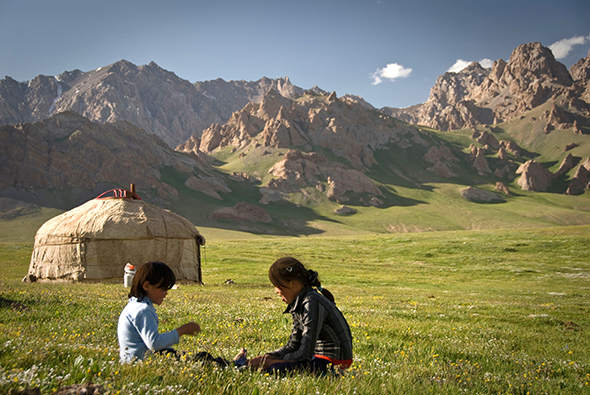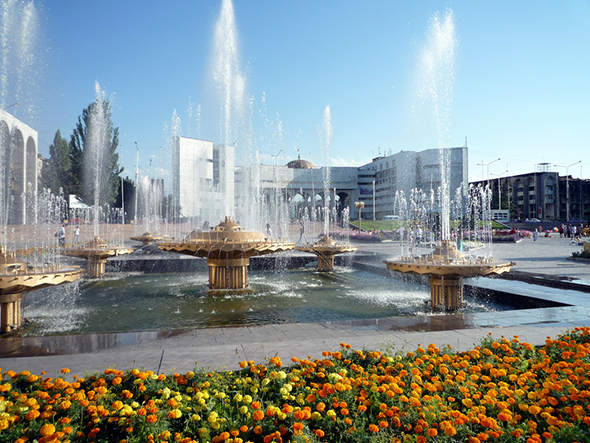By David A. Taylor
I had only walked three minutes from my hotel in Bishkek, Kyrgyzstan’s capital, when I stumbled upon a former empire.
Coming to Kyrgyzstan last fall, I wanted to see what remained of the Silk Road that snaked through that spiky Central Asian country for centuries, bridging the vastness of Asia and the West with caravans bearing silk, gems, and spices. In the ancient city of Osh in the south, for instance, remnants of Asian, Russian, and Persian realms still weave together in surprising ways.
That crisp morning in Bishkek I paused at bouquets of flowers leaning against a statue of Lenin. It was the Day of the Great Socialist Revolution, and Communist Party faithfuls still gather and make speeches here while waving red-starred flags and driving Cold War-vintage cars. Though now officially called the Day of Reconciliation and Agreement, the fact mattered little to party members who hooked up a portable sound system and addressed the crowd in the grand old, rambling style.
Kyrgyzstan is steeped in history, with a Russian presence going back to the 1800s, when the czar vied with Europe’s empire builders and redrew Russia’s map of Central Asia to include “Kirgizia,” prompting local uproar and causing many Kyrgyz.
The country eventually became a full Soviet Social Republic in 1936. Strolling across Bishkek’s vast Ala-Too Square, I passed another statue, this time one of the Soviet era’s leading authors, Kyrgyz writer Chingiz Aitmatov. In a display of Kyrgyzstan’s culture of reading, families were having their photos taken beside him.
Aitmatov, no apparatchik mouthpiece, probed the conscience of the Stalin era. My suitcase had a D.C. library copy of his play, The Ascent of Mount Fuji, which hinges on a reunion of World War II veteran friends in the mountains near Lake Issyk Kul. Secrets and guilt churn just below the surface, in a sort of a Soviet The Big Chill.
Leaving Bishkek, I headed south and after a ride through the storied markets of Osh, rode out into the snowy Pamir Mountains. The landscape evoked the Old American West: dry canyons, snow-tipped ridges and peaks, cowherds and a lifestyle that has changed little in centuries. These were the yurt-dwelling nomadic villages that had endured after the great empires fell.
In the south my guide was Arslaen, who had close-cropped hair and a personal history that includes a Greyhound trip from Seattle to New York and a year bartending in Turkey. The ringtone on his cell phone had a spaghetti Western sound—I thought it was the theme to High Plains Drifter, but he informed me that it was the Scorpions’s “Wind of Change.” His favorite author is Aitmatov.
In the town of Chong-Alai, where we had arranged a homestay with a local family, I could imagine the reality of life in a caravan. First thing in the morning and last thing at night, as I headed through the snow to the outhouse, real life on the Silk Road became bracingly clear. And though my host family hauled water long distances for cooking and drinking, in the talk over meals they showed a nimble humor and worldly awareness.
My Lonely Planet guide to Central Asia included a “Greendex” that rightly highlighted Kyrgyzstan’s investment in community-based tourism. By embracing a model that directly benefits local operators with minimal interference from middlemen, the country has managed to reinvent itself as a budget travel destination, and preserve its landscapes and local craft traditions in the process.
Kyrgyz music and storytelling reflect the ancient Muslim empires that took refuge in these mountains. As Michael Morgan recounts in his fascinating book, Lost History, when the Fāṭimid dynasty—which had shaped medieval Cairo as a global center of learning from the 10th to 12th centuries A.D.—shifted its base eastward to Persia, its sophisticated culture left a deep mark in the region.
Yet, conversations in Kyrgyzstan still turn unexpectedly to the Soviet era. One morning in Naryn, a pleasant town nestled between ridges 40 miles from China’s western edge, I sat with several country veterinarians as they talked about treating camels, performing C-sections on cows, and managing the risks of animal epidemics since the Soviet Union’s collapse.
This echoed a story I had heard in Bishkek from a Kyrgyz veterinarian named Madalbek who recalled even rougher days in the 1930s, when his grandfather struggled to protect their animals, first from the insurgents, then from Stalin. When the dictator’s men threatened to send the grandfather to the gulag, the family fled more than 100 miles east to Kashgar, another ancient trading hub in China. “Everyone just got on their horses and took off,” Madalbek recollected. “It was summer.”
And, of course, there is a third empire looming at the end of the Silk Road: China. In Naryn, I watched as truckers stopped in the white dusk of early winter to lay out chains on the ground in preparation for a starlit crossing of the jagged peaks. Seeing as we had already witnessed several rigs jackknifed on the icy switchbacks, this was a chilling encounter. I can still hear the sound of their chains rattling as we passed on the narrow road.
Back in Bishkek, I realized another empire stalking the Silk Road is the one I came from. When Bart Simpson appeared on my hotel TV screen with a star and crescent over his head, East and West truly merged.




















































































